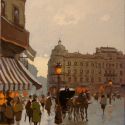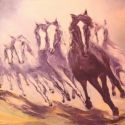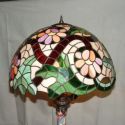
photo: http://www.successprinciplesonline.com/GB.jpg
Biography
From The Cantor's Son to the Peewee Quartet
Nathan Birnbaum was the ninth of twelve children born to Louis and Dorothy Birnbaum in New York City. His father was a substitute cantor at the local synagogue but did not work very often. During the flu epidemic of 1903, Louis had his chance to earn some real money but contracted the flu and died. Nattie (as he was known to his family) started working in 1903 after his father's death, shining shoes, running errands and selling newspapers.
When he landed a job as a syrup maker in a local candy shop at age seven, Nattie Birnbaum was discovered, as he recalled many years later.
We were all about the same age, six and seven, and when we were bored making syrup, we used to practice singing harmony in the basement. One day our letter carrier came down to the basement. His name was Lou Farley. Feingold was his real name, but he changed it to Farley. He wanted the whole world to sing harmony. He came down to the basement once to deliver a letter and heard the four of us kids singing harmony. He liked our style, so we sang a couple more songs for him. Then we looked up at the head of the stairs and saw three or four people listening to us and smiling. In fact, they threw down a couple of pennies. So I said to the kids I was working with, 'no more chocolate syrup. It's show business from now on.' We called ourselves the Peewee Quartet. We started out singing on ferryboats, in saloons and on street corners. We'd put our hats down for donations. Sometimes the customers threw something in the hats. Sometimes they took something out of the hats. Sometimes they took the hats.
Burns quit school in the fourth grade to go into show business full-time. Like many performers of his generation, he tried practically anything he could think of doing to entertain, from trick roller skating, teaching dance, singing, and adagio dancing in small-time vaudeville. During these years, he began smoking cigars---they became comic props as well as a real part of his way of life---and adopted the stage name by which he would be known for the rest of his life.
He normally partnered with a girl, sometimes in an adagio dance routine, sometimes comic patter. Though he had an apparent flair for comedy, he never quite clicked with any of his partners, until he met a young Irish Catholic lady in 1923. "And all of a sudden," he said famously (and repeatedly---never failing to get a laugh from it, either), in later years, "the audience realised I had a talent. They were right. I did have a talent---and I was married to her for 38 years."
Enter Gracie
"I love her---that's why": Gracie Allen, wife and comedy partner. When George flipped the act to make her the laugh-getter, the couple became major stars.
Grace Ethel Cecile Rosalie Allen was born into a show business family; she was the daughter of actress Ronnie Burns and, after being educated at Star of the Sea Convent School in girlhood she teamed in vaudeville with her sister, Bessie, in 1909.
She met George Burns and the two immediately launched a new partnership---but they didn't click until Burns cannily flipped the act around: after a Hoboken, New Jersey performance in which they tested the new style for the first time, Burns's hunch proved right. Gracie was the better laugh-getter, especially with the "illogical logic" that informed her responses to Burns's prompting comments or questions.
Allen's half of the act was known generally as a "Dumb Dora" act, named after a very early film of the same name that featured a scatterbrained female protagonist, but her "illogical logic" style was several cuts above the Dumb Dora stereotype, as was Burns's understated straight man. The twosome worked the new style tirelessly on the road, building a following, and finally playing the vaudevillian's dream: the Palace in New York. With success came love: They not only never again even thought of Gracie playing the straight woman and George going for the punch lines, they fell in love along the way and married in Cleveland, Ohio on 7 January 1926---somewhat daring for those times, considering Burns's Jewishness and Allen's Irish Catholic upbringing. (For her part, Allen also endeared herself to her in-laws by adopting his mother's favourite phrase, used whenever the older woman needed to bring her son back down to earth: "Nattie, you're a nice boy," using a diminutive of his given name. When Burns's mother died, Allen comforted her grief-stricken husband with the same phrase.)
Stage to Screen
Getting a start in motion pictures with a series of comic short films, their feature credits in the mid- to late-1930s included The Big Broadcast of 1932; International House in 1933; Six of a Kind in 1934; The Big Broadcast of 1936; The Big Broadcast of 1937; A Damsel in Distress in 1937 and College Swing in 1938, in which Bob Hope made one of his early film appearances.
Burns and Allen were indirectly responsible for the Bob Hope and Bing Crosby "Road" pictures. In 1938, William LeBaron, producer and managing director at Paramount, had a script prepared by Don Hartman and Frank Butler. It was to star Burns and Allen with a young crooner named Bing Crosby. The story didn't seem to fit George and Gracie, so LeBaron ordered Hartman and Butler to rewrite their script to fit two male co-stars—Hope and Crosby. The script was titled Road to Singapore and it made motion-picture history.
Burns and Allen were always praised as having one of the happiest marriages in show business, which was true enough; friends said that they were to marriage what Rogers and Hammerstein were to music: style, dignity, and class all the way. But Burns eventually admitted that even their marriage suffered at least one stressful enough period that he did the unthinkable, after the stress climaxed in an argument over a pricey table centerpiece Gracie coveted: he had a very brief affair with a Las Vegas showgirl. To the day he died he considered it the biggest regret of his life---and considered himself fortunate to have his wife's forgiveness. Typically, Burns discovered in an offhand way that his wife knew what he had done: he overheard what would have sounded anywhere else like a classic Gracie Allen punch line. He overheard Gracie shopping with a friend and saying, "You know, I really wish George would cheat on me again. I could use a new centerpiece."
Whether or not she got the new centerpiece, she never had to worry about her husband straying again.
The Radio Stars
Burns and Allen first made it to radio as the comedy relief for bandleader Guy Lombardo, which didn't always sit well with Lombardo's home audience. In his later memoir, The Third Time Around, Burns revealed a college fraternity's protest letter, complaining that they resented their weekly dance parties with their girl friends to "Thirty Minutes of the Sweetest Music This Side of Heaven" had to be broken into by that droll vaudeville team.
In time, though, Burns and Allen found their own show and radio audience, first airing on February 15, 1932 and concentrating on their classic stage routines plus sketch comedy in which the Burns and Allen style was woven into different little scenes, not unlike the short films they made in Hollywood. They were also good for a clever publicity stunt, none more so than the hunt for Gracie's missing brother---a hunt that included Gracie turning up on other radio shows searching for him as well. They also cooked up a clever stunt involving Gracie's fictitious run for the U.S. presidency ("Everybody knows a woman is much better than a man at introducing bills into the house," was a typical Gracie "campaign" crack)---clever enough that Allen actually got votes in the November 1940 election!
Portrayed at first as younger singles, with Allen the object of both Burns's and announcer Bill Goodwin's affections, in time the show was adapted to present them as the married couple they actually were, this by 1940 in a bid to rejuvenate slipping ratings: the audience was simply too familiar with their solid married life to continue portraying them as singles. For a short time, Burns and Allen had a rather distinguished and popular musical director: swing era titan Artie Shaw, who also appeared as a character in some of the show's sketches.
Burns and his fellow writers thus redeveloped the show as a situation comedy, focusing on the couple's married life and life among various friends and neighbours, until the characters of Harry and Blanche Morton entered the picture to stay. Like The Jack Benny Program, the new George Burns & Gracie Allen Show portrayed George and Gracie as entertainers with their own weekly radio show. Bill Goodwin remained, his character as 'girl-crazy' as ever, and the music was now handled by Meredith Willson (later to be better known for composing the play The Music Man). Wilson also played himself on the show as a naive, friendly, girl-shy fellow. The new format's success made it one of the few classic radio comedies to completely re-invent itself and regain major fame.
Supporting Players
The supporting cast during this phase included Mel Blanc as the melancholy, ironically named "Happy Postman"; Bea Benaderet and Hal March (later infamous as the host of The $64,000 Question) as neighbors Blanche and Harry Morton; and the various members of Gracie's ladies' club, the Beverly Hills Uplift Society. One running gag during this period, stretching into the television era, was Burns' questionable singing voice, as Gracie lovingly referred to her husband as "Sugar Throat." The show made and maintained a top ten rating for the rest of its radio life.
They also took the show to CBS in 1948, after having spent their entire radio career to date on NBC. They moved at the beckon of good friend Jack Benny, who had been courted by CBS when he hit a negotiating impasse with NBC over the corporation he set up to package his show, the better to put more of his earnings on a capital-gains basis and avoid the punishing 80-80 percent taxes slapped on very high earners in the World War II era. When CBS czar William S. Paley convinced Benny to move to CBS (Paley, among other things, impressed Benny with his attitude that the performers make the network, not the other way around as NBC chief David Sarnoff reputedly believed), Benny in turn convinced several NBC stars to join him, including Burns and Allen. And thus did CBS reap the strike when Burns and Allen moved to television in 1950.
Inside and Outside the Box
On television, The George Burns & Gracie Allen Show merely put faces to the radio characters audiences had come to love. Burns made four significant changes (five, if you count the 'parade' of actors portraying Harry Morton--Hal March, John Brown (the comically morbid undertaker "Digger O'Dell" on the radio program The Life Of Riley), Fred Clark (veteran movie and television character actor), and Larry Keating (later a co-star with Alan Young on Mister Ed):
He "stepped out of" the show more often than not and chatted with the home audience, telling understated jokes and commenting wryly about what show characters were doing or undoing.
When Bill Goodwin left after the earliest episodes, Burns hired veteran radio announcer Harry Von Zell to succeed him. Von Zell was cast as the good-natured, easily confused (by Gracie and just about anyone else) Burns and Allen announcer and buddy, and he also became one of the show's running gags, when his involvement in yet another one of Gracie's harebrained ideas would get him fired at least once a week by George.
The first shows were simply a copy of the radio format, complete with lengthy and integrated commercials for sponsor Carnation Evaporated Milk by Goodwin. However, what worked well on radio appeared forced and plodding on television. The show was changed into the now-standard situation comedy format, with the comercials distinct from the plot.
Midway through the show's run, the Burns's two adopted children, Sandra and Ronald, began to feature on the show, Sandy as an occasional drama school classmate of Ronnie, and Ronnie himself as George and Gracie's son who held his parents' comedy style in befuddled contempt and as something the "serious" drama student just didn't aspire to be.
Burns and Allen also took a cue from Lucille Ball and Desi Arnaz's Desilu Productions and formed a company of their own, McCadden Corporation, headquartered on the General Service Studio lot in the heart of Hollywood and set up to film television shows and commercials. Besides their own hit show, the couple's company produced such television series as The Bob Cummings Show (a.k.a. Love That Bob); The People's Choice, starring Jackie Cooper; Mona McClusky, starring Juliet Prowse; and Mister Ed, starring Alan Young and a talented "talking" horse.
The George Burns Show
The George Burns & Gracie Allen Show ran on CBS through 1958, when George at last consented to Gracie's retirement. The onset of heart trouble had exhausted her of full-time work and she had been anxious to stop for a few years, but couldn't say no to George. Perhaps in gratitude for that kind of trouping, George finally agreed.
But then he made one of the biggest mistakes of his career: he continued the show without her. The full cast returned for The George Burns Show, and it was only too obvious what was missing. Trying to do Burns and Allen without Allen was simply too much to expect when even newcomers to the show could pinpoint exactly where the classic Gracie-isms were supposed to drop, and the show expired after a year.
Burns had one more television inning to play, a promising situation comedy he created (and co-starred in) with Connie Stevens, Wendy & Me, in which he served primarily as the narrator, and secondarily as the advisor to Stevens's Gracie-like character. This time, though the show may not have survived as long as his old one did, it was George who had to withdraw because of Gracie's health.
The Sunshine Boy
Gracie Allen's death of a heart attack in 1964 devastated Burns, who immersed himself in work merely to survive. McCadden Productions co-produced the television series No Time for Sergeants, based on the hit Broadway play. At the same time, he toured the U.S. playing nightclub and theater engagements with such diverse partners as Carol Channing, Dorothy Provine, Jane Russell, Connie Haines, and Berle Davis. He also performed a series of solo concerts, playing university campuses, New York's Philharmonic Hall and winding up a successful season at the prestigious Carnegie Hall, where he wowed a capacity audience with his show-stopping songs, dances, and jokes.
Then, in 1974, Jack Benny signed to play one of the lead roles in the film version of Neil Simon's The Sunshine Boys. Benny's health had begun to fail, however, and he advised his manager Irving Fein to let longtime friend Burns fill in for him on a series of nightclub dates to which Benny had committed around the U.S. "The Sunshine Boys is going to keep me busy for six months," Benny told Fein, "so why don't you give the work to George?"
Burns did it because he enjoyed his work (he certainly didn't need the money) and liked to keep busy. To Burns, retirement meant shriveling up and dying; perhaps he was haunted, too, by how Gracie had been through exactly that, no matter how much she sought retirement for the sake of her health. As he recalled years later: [2] "The happiest people I know are the ones that are still working. The saddest are the ones who are retired. Very few performers retire on their own. It's usually because no one wants them. Six years ago Sinatra announced his retirement. He's still working."
89 years ageless and in top game shape: George Burns in 1985.
But Benny wasn't even able to work on The Sunshine Boys; he'd been diagnosed at last with pancreatic cancer and died soon thereafter. Burns replaced his best friend in the film as well as the club tour. And it turned out to be the second biggest break of his career: his performance as faded vaudevillian Al Lewis earned him an Academy Award for Best Supporting Actor and secured his career resurgence for good. Until Jessica Tandy nailed an Oscar for Driving Miss Daisy many years later, George Burns was the oldest Oscar winner in the history of the Academy Awards.
The Droll Deity
In 1977, Burns made another hit film, Oh, God!, playing the title role opposite singer John Denver as an earnest but befuddled supermarket manager whom God picks at random to revive His message. The image of Burns in a sailor's cap and light springtime jacket as the droll Almighty ("Oh, every now and then I work a little miracle just to keep my hand in. My last miracle was the 1969 Mets. Before that, I think you'd have to go back to the Red Sea---aaahh, that was a beauty") was even more irresistible; it seemed as though half the nation's comedians were including clever wisecracks about the octogenarian Burns playing a Supreme Being who probably wasn't as old as Burns. (Burns, for his part, couldn't resist joining in the fun, and at a celebrity roast in his honour former actor and future U.S. president Ronald Reagan adapted a Burns crack: "When George was growing up, the Top Ten were the Ten Commandments.")
Oh, God! inspired two sequels Oh, God! Book Two (in which the Almighty this time engages a wise-beyond-her-years schoolgirl to spread the word) and Oh, God! You Devil---in the second of those, Burns played a dual role as droll God and the even more droll Devil, with the soul of a would-be songwriter at stake. With any other actor playing God, the two films would probably have died an instant death. So iconic had Burns become that almost anything he did received at least one cycle of viewing---almost. Not even Burns could have rescued Sgt. Pepper's Lonely Hearts Club Band, the ill-advised film (the Bee Gees, Peter Frampton, and Earth, Wind & Fire also featured in the film) based on the Beatles's album of the same name. Burns's offhand description (in The Third Time Around) of Earth, Wind & Fire as "sounding like the weather report" was probably better (and certainly funnier) than the film was.
Burns continued to work well into his nineties, writing a number of books and appearing in films and television. Perhaps the best remembered of those was 18 Again, based on a half-novelty, country music based hit single he enjoyed, "I Wish I Was 18 Again." ("Why shouldn't I be a country singer?" he deadpanned, typically. "I'm older than most countries.") In this film, he played a self-made millionaire industrialist who switched bodies with his awkward, artistic, eighteen-year-old grandson (played by Charlie Schlatter) after the Rolls Royce they are riding in crashes into a storefront, leaving the grandfather (in theory) in a coma and on life support. (Classically, Burns delivered one of his typical droll observations, when he realises he and his grandson have switched bodies: "Oh, David, did you get the short end of this deal!")
The Final Years. Really.
Burns's stage persona in his final phase of professional life included an image as a sexy senior citizen (very senior: "I'd love to date women my own age---but there are no women my own age") that became a running gag for the rest of his career. He often shared the social company of very attractive young women, but he was never known to be crude or boorish with them and had a reputation for treating them with respect.
But his heart still belonged to Gracie, all those years after her death. He never remarried; indeed, except for consenting once to perform one with Bernadette Peters, he never performed a Burns and Allen-style routine again. Millions believed him when They Still Love Me In Altoona disclosed that he found it impossible to sleep until he decided one night to sleep in Gracie's bed (she'd had a separate bed during her illness)---and never looked back. He also visited her grave at least once a month, professing to talk to her about whatever he was doing at the time---including, he said, trying to decide whether he really should accept the Sunshine Boys role Jack Benny had had to abandon because of his own failing health.
In time, however, the likelihood that Burns would live to see his 100th birthday became a running gag in his (and plenty of other admiring comedians') stage work, but he was (no pun intended) dead serious about living that long---he even booked himself to play the London Palladium as a 100th birthday celebration. But he suffered a serious injury in a 1994 fall, and only then did his own health decline in earnest. He did live to 100; his birthday in 1996 was a national holiday in everything but name, but Burns was no longer in condition to get around much, never mind perform. Forty-nine days after that milestone birthday, George Burns died.
Whether or not any comic cracked in tribute, "Now God can retire---his logical successor has arrived," is lost to history.
As much as he looked forward to reaching age 100, Burns also liked to say he looked forward to death: he believed to the day he died that he would be with Gracie again in heaven. For millions of listeners and viewers over several generations, the comedy of George Burns with and without Gracie Allen was its own slice of heaven. Enough remains available in very large quantity---many of their classic radio shows on compact disc; their legendary short sketch films in periodic showings on the Turner Classic Movies cable network; videos of their television show---that this world can have them as long as they'll have each other.
Trivia
When Gracie Allen was buried, her tomb marker read "Gracie Allen Burns - Beloved Wife and Mother." After George was interred with her, this was replaced with one saying "Gracie Allen and George Burns - Together Again."
In the movie Star Trek IV: The Voyage Home, the two humpback whales are named George and Gracie after Burns and Allen.
In an episode on The Simpsons, it is implied that the fictional character Montgomery Burns was George Burns' brother since they both have the last name. Young George Burns sounded somewhat like Krusty The Clown.
A recording exists of Burns and other comedians "working blue" in front of a stag audience at a Masquers Club roast in the mid-1950s.
Many television viewers thought George Burns played Max as a guest appearance in The Fresh Prince of Bel-Air. It was played by another actor who quite resembles Burns because of cigar smoking and one-liners.
Filmography
Lambchops (1929) (short subject)
Fit to Be Tied (1930) (short subject)
Pulling a Bone (1931) (short subject)
The Antique Shop (1931) (short subject)
Once Over, Light (1931) (short subject)
100% Service (1931) (short subject)
Your Hat (1932) (short subject)
Walking the Baby (1932) (short subject)
Oh, My Operation (1932) (short subject)
The Babbling Book (1932) (short subject)
The Big Broadcast (1932)
Let's Dance (1933) (short subject)
Hollywood on Parade No. 9 (1933) (short subject)
International House (1933)
College Humor (1933)
Six of a Kind (1934)
We're Not Dressing (1934)
Many Happy Returns (1934)
Love in Bloom (1935)
Here Comes Cookie (1935)
The Big Broadcast of 1936 (1935)
The Big Broadcast of 1937 (1936)
College Holiday (1936)
A Damsel in Distress (1937)
College Swing (1938)
Honolulu (1939)
Screen Snapshots: Famous Fathers and Sons (1946) (short subject)
Screen Snapshots: Hollywood Grows Up (1954) (short subject)
Screen Snapshots: Hollywood Beauty (1955) (short subject)
The Solid Gold Cadillac (1956) (narrator)
All About People (1967) (short subject) (narrator)
A Look at the World of SOYLENT GREEN (1973) (short subject)
The Lion Roars Again (1975)
The Sunshine Boys (1975)
Oh, God! (1977)
Sgt. Pepper's Lonely Hearts Club Band (1978)
Movie Movie (1978) (Cameo)
Just You and Me, Kid (1979)
Going in Style (1979)
Oh, God! Book II (1980)
Oh, God! You Devil (1984)
18 Again! (1988)
A Century of Cinema (1994) (documentary)
Radioland Murders (1994)
Radio series
The Robert Burns Panatella Show 1932–1933; CBS
In their debut series, George and Gracie shared the bill with Guy Lombardo and his orchestra. The pair launched themselves into national stardom with their first major publicity stunt, Gracie's ongoing search for her missing brother.
The White Owl Program 1933–1934; CBS
The Adventures of Gracie 1934–1935; CBS
The Campbell's Tomato Juice Program 1935–1937; CBS
The Grape Nuts Program 1937–1938; NBC
The Chesterfield Program 1938–1939; CBS
The Hinds Honey and Almond Cream Program 1939–1940; CBS
This series featured another wildly successful publicity stunt which had Gracie running for President of the United States.
The Hormel Program 1940–1941; NBC
Advertised a brand new product called Spam; this show featured musical numbers by jazz great Artie Shaw.
The Swan Soap Show 1941–1945; NBC, CBS
This series featured a radical format change, in that George and Gracie played themselves as a married couple for the first time, and the show became a full-fledged domestic situation comedy. This was George's response to a marked drop in ratings under the old "Flirtation Act" format.
Maxwell House Coffee Time 1945–1949; NBC
The Amm-i-Dent Toothpaste Show 1949–1950; CBS
TV series
The George Burns and Gracie Allen Show 1950–1958; CBS
Broadcast live every other week for the first two seasons, 26 episodes per year. Starting in the third season, all episodes were filmed and broadcast weekly, 40 episodes per year. A total of 291 episodes were created.
The George Burns Show 1958–1959; NBC
An unsuccessful attempt to continue the format of The George Burns and Gracie Allen Show without Gracie, the rest of the cast intact.
Wendy and Me 1958–1959; NBC
George plays narrator in this short-lived series, just as he had in The George Burns and Gracie Allen Show, but with far less on-screen time, as the focus is on a young couple played by Connie Stevens and Ron Harper. Connie Stevens is, essentially, playing a version of Gracie's character.
George Burns Comedy Week 1985; CBS
Another short-lived series, a weekly comedy anthology program whose only connecting thread was George's presence as host. He does not appear in any of the actual storylines. He was 89 years old when the series was produced.

































